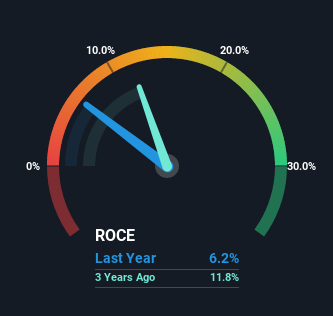- United States
- /
- Specialty Stores
- /
- NasdaqGS:SPWH
Sportsman's Warehouse Holdings (NASDAQ:SPWH) Will Be Hoping To Turn Its Returns On Capital Around
If we want to find a potential multi-bagger, often there are underlying trends that can provide clues. Ideally, a business will show two trends; firstly a growing return on capital employed (ROCE) and secondly, an increasing amount of capital employed. Basically this means that a company has profitable initiatives that it can continue to reinvest in, which is a trait of a compounding machine. However, after investigating Sportsman's Warehouse Holdings (NASDAQ:SPWH), we don't think it's current trends fit the mold of a multi-bagger.
What Is Return On Capital Employed (ROCE)?
If you haven't worked with ROCE before, it measures the 'return' (pre-tax profit) a company generates from capital employed in its business. To calculate this metric for Sportsman's Warehouse Holdings, this is the formula:
Return on Capital Employed = Earnings Before Interest and Tax (EBIT) ÷ (Total Assets - Current Liabilities)
0.062 = US$36m ÷ (US$982m - US$400m) (Based on the trailing twelve months to April 2023).
So, Sportsman's Warehouse Holdings has an ROCE of 6.2%. Ultimately, that's a low return and it under-performs the Specialty Retail industry average of 14%.
See our latest analysis for Sportsman's Warehouse Holdings

In the above chart we have measured Sportsman's Warehouse Holdings' prior ROCE against its prior performance, but the future is arguably more important. If you'd like, you can check out the forecasts from the analysts covering Sportsman's Warehouse Holdings here for free.
What Does the ROCE Trend For Sportsman's Warehouse Holdings Tell Us?
When we looked at the ROCE trend at Sportsman's Warehouse Holdings, we didn't gain much confidence. Around five years ago the returns on capital were 23%, but since then they've fallen to 6.2%. On the other hand, the company has been employing more capital without a corresponding improvement in sales in the last year, which could suggest these investments are longer term plays. It's worth keeping an eye on the company's earnings from here on to see if these investments do end up contributing to the bottom line.
On a separate but related note, it's important to know that Sportsman's Warehouse Holdings has a current liabilities to total assets ratio of 41%, which we'd consider pretty high. This effectively means that suppliers (or short-term creditors) are funding a large portion of the business, so just be aware that this can introduce some elements of risk. Ideally we'd like to see this reduce as that would mean fewer obligations bearing risks.
The Bottom Line
Bringing it all together, while we're somewhat encouraged by Sportsman's Warehouse Holdings' reinvestment in its own business, we're aware that returns are shrinking. And in the last five years, the stock has given away 14% so the market doesn't look too hopeful on these trends strengthening any time soon. On the whole, we aren't too inspired by the underlying trends and we think there may be better chances of finding a multi-bagger elsewhere.
Since virtually every company faces some risks, it's worth knowing what they are, and we've spotted 2 warning signs for Sportsman's Warehouse Holdings (of which 1 can't be ignored!) that you should know about.
While Sportsman's Warehouse Holdings isn't earning the highest return, check out this free list of companies that are earning high returns on equity with solid balance sheets.
New: Manage All Your Stock Portfolios in One Place
We've created the ultimate portfolio companion for stock investors, and it's free.
• Connect an unlimited number of Portfolios and see your total in one currency
• Be alerted to new Warning Signs or Risks via email or mobile
• Track the Fair Value of your stocks
Have feedback on this article? Concerned about the content? Get in touch with us directly. Alternatively, email editorial-team (at) simplywallst.com.
This article by Simply Wall St is general in nature. We provide commentary based on historical data and analyst forecasts only using an unbiased methodology and our articles are not intended to be financial advice. It does not constitute a recommendation to buy or sell any stock, and does not take account of your objectives, or your financial situation. We aim to bring you long-term focused analysis driven by fundamental data. Note that our analysis may not factor in the latest price-sensitive company announcements or qualitative material. Simply Wall St has no position in any stocks mentioned.
About NasdaqGS:SPWH
Sportsman's Warehouse Holdings
Operates as an outdoor sporting goods retailer in the United States.
Good value with imperfect balance sheet.
Market Insights
Community Narratives



